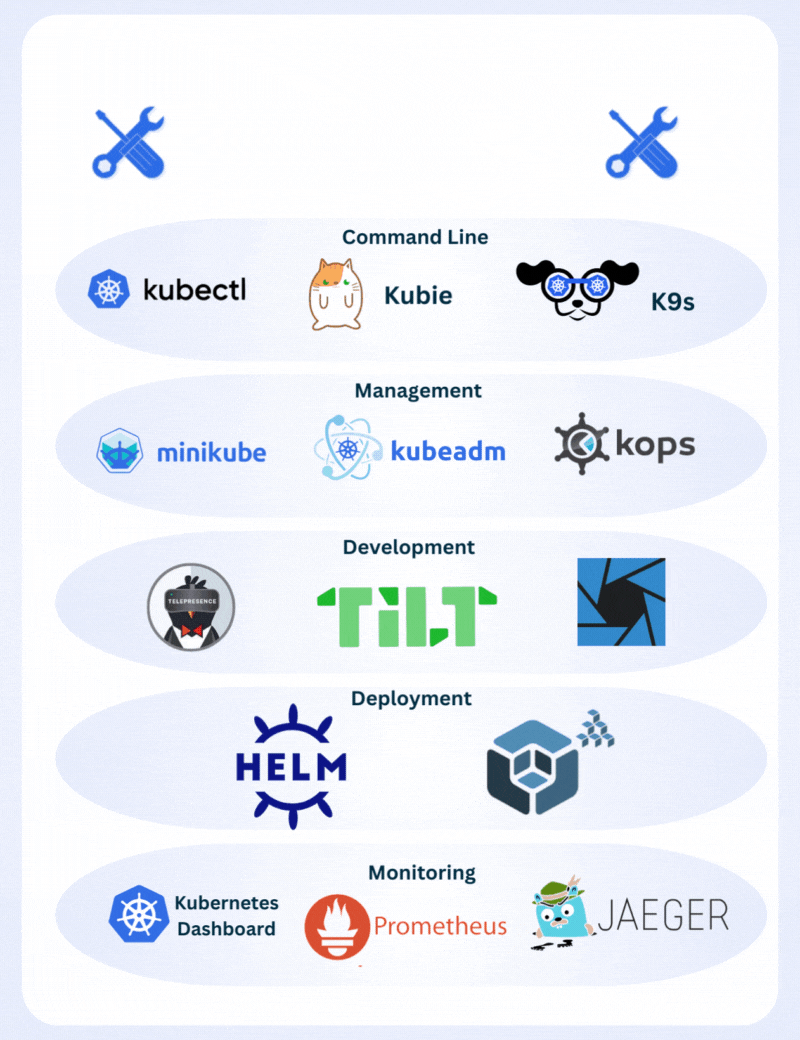Kubernetes Essential Tools
As Kubernetes continues to gain popularity, the ecosystem around it has grown significantly, offering a wide range of tools to simplify and enhance the Kubernetes experience. These tools cover various aspects of Kubernetes, including deployment, monitoring, development, and management, catering to the diverse needs of Kubernetes users. In this article, we'll explore some essential tools that can help you work more effectively with Kubernetes.

Command Line Tools
kubectl
kubectl is the quintessential command-line tool for interacting with Kubernetes clusters, allowing users to deploy applications, inspect and manage cluster resources, and view logs. It is compatible with any operating system that supports Kubernetes, offering a versatile toolkit for Kubernetes management.
Usage:
kubectl get pods
kubectl describe pod my-pod
kubectl logs my-pod
kubie
kubie is a more context-aware CLI tool designed to improve the Kubernetes user experience. It simplifies context switching and namespace management, making it easier for users to work with multiple clusters or namespaces without losing track of their current operational context.
Usage:
kubie ctx
kubie ns
k9s
k9s provides a terminal-based UI to interact with your Kubernetes clusters, making it easier to monitor and manage your cluster's resources. It enhances the kubectl experience by offering a more interactive and visually appealing interface, improving efficiency and productivity for Kubernetes administrators and developers.
Usage:
k9s
Management
minikube
Minikube is an excellent tool for users looking to run Kubernetes locally. It simplifies the process by managing a single-node cluster inside a VM on your computer. This tool is perfect for development, testing, and trying out new features.
Learn more about minikubekubeadm
Kubeadm streamlines the process of getting a Kubernetes cluster up and running. It provides the necessary tools to initiate the cluster, manage its lifecycle, and perform tasks such as upgrades and configuration changes. It's a fundamental tool for anyone looking to deploy Kubernetes clusters.
Learn more about kubeadmkOps
kOps is a powerful tool designed for creating, destroying, upgrading, and maintaining high-availability Kubernetes clusters. It's user-friendly and ideal for managing clusters in a production environment, offering robust features that cater to demanding requirements.
Learn more about kOpsManaged Kubernetes Platforms
Managed Kubernetes platforms provide a hands-off approach to cluster management, handling the underlying infrastructure, scaling, and maintenance. These platforms offer various features like built-in authentication, logging, monitoring, and self-healing, making Kubernetes accessible to a broader audience.
Examples:- Amazon EKS
- Google Kubernetes Engine (GKE)
- Microsoft Azure Kubernetes Service (AKS)
- DigitalOcean Kubernetes
- IBM Cloud Kubernetes Service
- Oracle Container Engine for Kubernetes
- Alibaba Cloud Container Service for Kubernetes
- Red Hat OpenShift
- Rancher
- VMware Tanzu Kubernetes Grid
- Linode Kubernetes Engine
- Platform9 Managed Kubernetes
- StackPath Edge Compute Network
- Canonical Kubernetes
- The list goes on...
Development Tools
Telepresence
Telepresence dramatically changes the Kubernetes development workflow by allowing developers to run a single service locally while connecting that service to a remote Kubernetes cluster. This approach facilitates rapid development and testing by enabling instant feedback on code changes without the need to deploy the code to the cluster for each update.
Learn more about TelepresenceTilt
Tilt streamlines the development of microservices by offering live updates to your Kubernetes environment. It allows developers to automate the build and deploy process in real-time, enabling a more iterative and efficient development cycle. Tilt focuses on improving productivity and reducing the feedback loop in microservices development.
Learn more about tiltLens IDE
Lens IDE is a powerful integrated development environment specifically designed for Kubernetes, offering developers a comprehensive view of their clusters. It simplifies cluster management, resource monitoring, and application development, providing an intuitive interface that enhances the overall development experience on Kubernetes.
Learn more about Lens IDEDeployment
Helm
Helm is often referred to as the 'app store' for Kubernetes, offering a powerful and flexible way to manage Kubernetes applications. Helm Charts help you define, install, and upgrade even the most complex Kubernetes application, streamlining the deployment process.
Learn more about HelmKubespray
Kubespray is a versatile open-source tool for deploying and managing Kubernetes clusters. It provides a straightforward and consistent way to set up clusters, leveraging popular automation tools like Ansible for infrastructure provisioning, making it a reliable choice for infrastructure as code practices.
Learn more about KubesprayMonitoring
Kubernetes Dashboard
The Kubernetes Dashboard offers a user-friendly web-based interface for managing and monitoring your Kubernetes cluster. While not installed by default, it can be easily added to your cluster as a pod, providing a visual overview of the cluster's state and performance.
Learn more about Kubernetes DashboardPrometheus
Prometheus is a widely adopted open-source monitoring solution that seamlessly integrates with Kubernetes. It offers a robust set of features to collect, store, and query metrics, providing valuable insights into the performance and health of your applications and infrastructure.
Learn more about PrometheusJaeger
Jaeger, a distributed tracing system, leverages OpenTelemetry to provide detailed insights into the behavior of your distributed applications. It's an all-in-one solution for monitoring, troubleshooting, and visualizing the interactions between your services.
Learn more about JaegerConclusion
As Kubernetes continues to evolve, the ecosystem around it will continue to expand, offering a wide range of tools to enhance the Kubernetes experience. The tools mentioned in this article are just a few examples of the many available, catering to the diverse needs of Kubernetes users. Whether you're a developer, administrator, or operator, these tools can help you work more effectively with Kubernetes, simplifying deployment, monitoring, development, and management tasks.